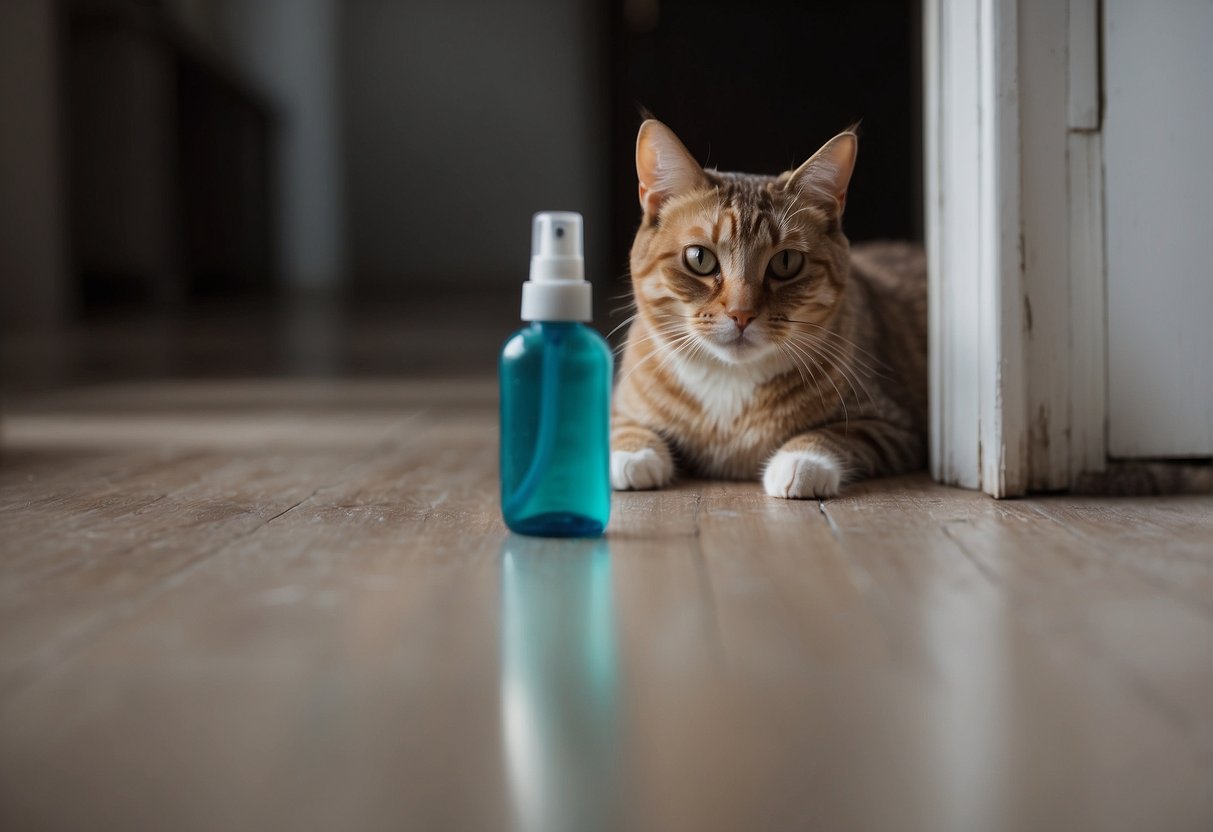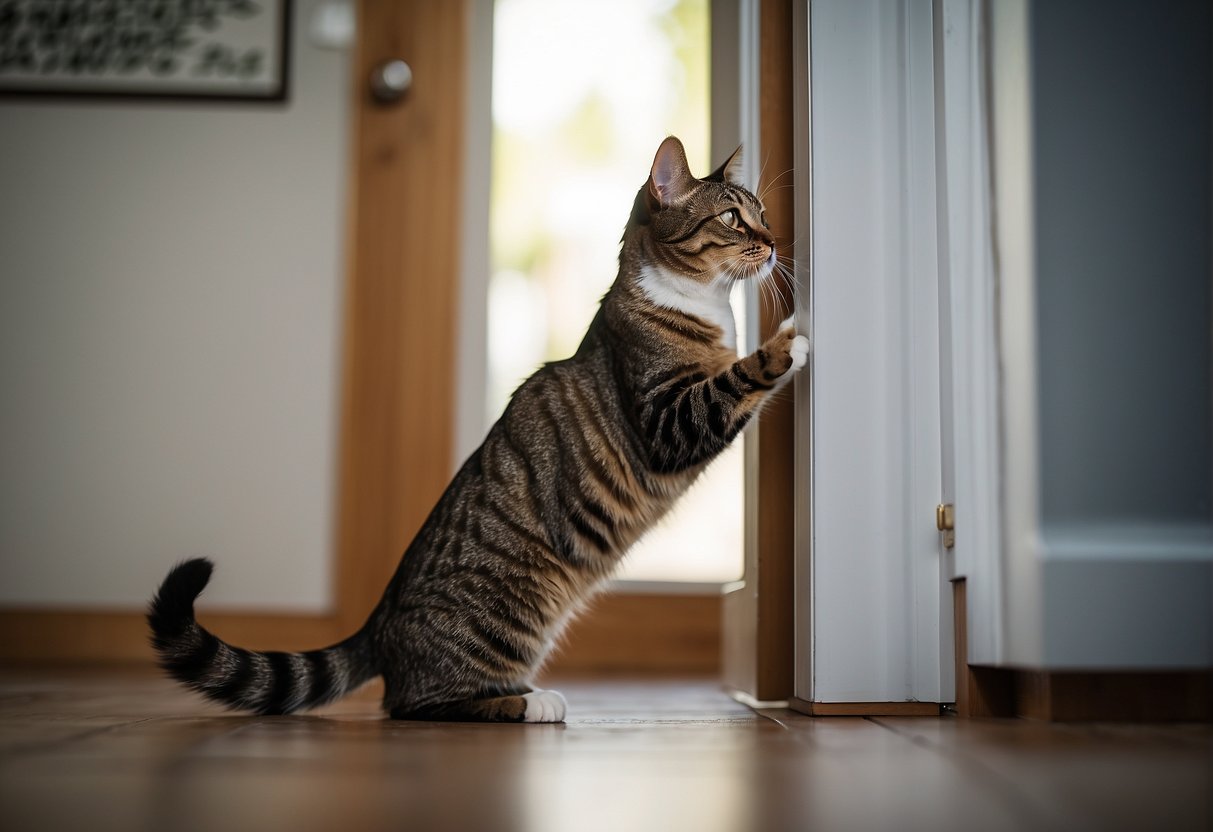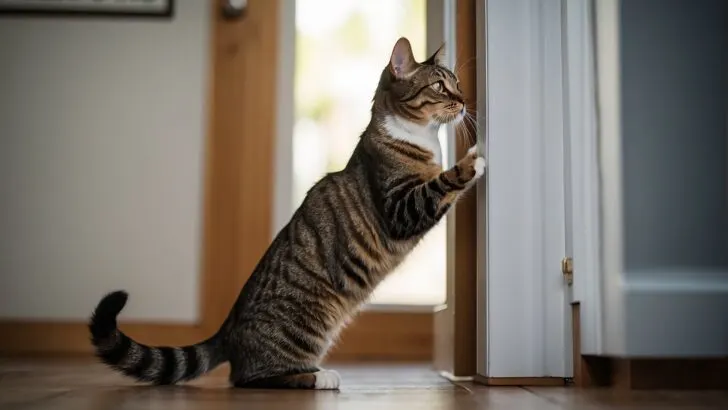Getting your cat to stop scratching the door can be a bit of a puzzle, but it’s a behavior that many owners tackle for the sake of their doors—and sanity! Your feline friend isn’t doing this to upset you; it’s a natural behavior driven by instinctual needs such as marking territory, stretching their muscles, and shedding old nail sheaths.

If one of your doors has become the unfortunate target of your cat’s claws, it’s essential to investigate the motivation behind this behavior.
Cats often scratch for attention, so if your furry pal is relentlessly pawing at the door every morning, they might be signaling that it’s time for breakfast or that they just want some company. In my own experience, providing alternative scratching options redirected the behavior.
Scratching posts placed strategically around the house gave my cat appropriate outlets for their scratching, which helped save my doors from further artwork.
It’s also beneficial to enrich your cat’s environment with various cat toys and high perches, as these additions can reduce the likelihood of door-scratching habits forming in the first place. Keeping your cat both physically and mentally stimulated means they are less likely to find mischief–in this case, less likely to treat your doors as their personal scratch pads.
Cat Behavior and Scratching Needs

Before finding ways to stop your cat from scratching the door, it’s essential to understand why they do it and address their natural needs.
The Role of Claws and Scratching
Claws are vital tools for cats. They use their claws for defense, hunting, and climbing. Importantly, scratching is a maintenance behavior for claws. When cats scratch, they remove the dead outer layer of their claws, revealing sharp new nails underneath—much like how you would trim your own nails for hygiene.
It’s crucial for your cat’s claw health and should be encouraged, though directed at appropriate surfaces.
Scratching as a Natural Behavior
Scratching is a deeply ingrained behavior in cats. It isn’t done solely to sharpen claws; it’s also a way for cats to express themselves.
Your feline companion might scratch more when excited or stressed. It is a means of communicating and has roots in natural habit. By leaving both a visual mark and a scent released from special glands in their paws, they signal their presence to other felines—a form of marking territory.
Significance of Territory and Stretching
Cats are territorial animals, and scratching plays a role in asserting that territory. The marks a cat leaves are a statement: “This is my space.” Scratching also serves as a form of exercise for cats, allowing them to stretch their bodies and flex their feet and claws.
This act of stretching is essential for a cat’s flexibility and overall well-being. Observing when and where your cat scratches can offer insights into their territorial behavior, which can be a cornerstone in addressing unwanted scratching.
Creating a Deterrent for Door Scratching
If your feline friend has taken a liking to using your door as a scratch post, rest easy knowing there are effective methods you can employ to discourage this behavior.
Using Repellents and Barriers
Repellents can serve as a first line of defense to prevent your cat from scratching the door. A variety of safe, cat-specific repellents are available, with pheromones being especially useful.
These synthetic pheromones mimic the natural ones cats use to mark their territory, which can discourage scratching in undesired locations. You can apply a pheromone spray directly to the door or use a diffuser nearby.
As for barriers, you might consider attaching a piece of cardboard or a scratch mat to the lower part of the door. Cats often prefer the texture of cardboard and will likely opt to scratch the cardboard rather than the door itself.
Double-Sided Tape and Foil Tricks
Double-sided tape can be a highly effective deterrent. Apply strips of tape to the areas of the door where your cat scratches most often. Cats dislike the sticky sensation on their paws and are likely to avoid scratching there again.
Alternatively, covering the door’s scratching area with tin foil can also deter your cat. The unusual texture and sound of the foil are generally unappealing to cats, which can stop the scratching behavior.
Installing a Cat Door
If your cat is scratching at the door to be let through to another space, installing a cat door may resolve the issue. Cat doors give your pet free access to the rooms they want to explore, reducing frustration and the associated scratching.
Choose a cat door size appropriate for your cat’s breed and size to ensure they can pass through comfortably.
Providing Alternatives to the Door
To prevent your cat from treating the door as a personal scratching pad, you’ll need to offer appealing alternatives. By strategically selecting scratching posts and encouraging their use with catnip or toys, your feline friend will be more likely to leave the door unscathed.
Choosing the Right Scratching Posts and Locations
Selecting the perfect scratching post involves considering texture, stability, and height. Cats have varied preferences, but many enjoy sisal fabric or rope. Ensure the post is tall enough for a full stretch and sturdy to prevent tipping. Place scratching posts near the door your cat favors to make it an easier choice than the door itself.
- Textures: Sisal, carpet, wood, or cardboard
- Stability: Heavy base or wall-mounted options
- Placement: Close to preferred scratching areas
The Attraction of Catnip and Toys
Sprinkle a bit of catnip on the new scratching posts to entice your kitty, or attach toys to the top to make it more engaging. Scratching pads infused with catnip can be a magnet for some felines and combining it with their favorite playthings only doubles the allure.
- Catnip: Fresh or dried to sprinkle or pre-infused options
- Toys: Hanging toys or interactive toys to attach to the post
Redirecting Energy with Play
Enrich your cat’s environment with ample opportunities for play and mental stimulation. Interactive toys, like laser pointers or feather wands, can redirect excess energy away from the door. Establishing regular playtimes helps your cat to associate these positive activities with their own spaces and devices away from the door.
- Interactive Toys: Feather wands, laser pointers, puzzle feeders
- Energy Redirection: Structured playtimes and exploration spaces like cat trees
Reinforcing Good Habits and Addressing Underlying Issues
To effectively encourage your cat to stop scratching the door, understanding and reinforcing good habits while addressing their underlying needs is crucial.
Effective Training Techniques
Employing positive reinforcement is essential when training your cat. Whenever your cat chooses an appropriate scratch surface, reward them immediately to reinforce the behavior.
A treat or a quick play session can serve as a potent reward. Discourage door scratching by making the door less attractive; double-sided tape or a plastic sheet can deter your cat without causing harm.
Consistency in Routine and Rewards
Maintain a routine that includes regular feeding, playtime, and relaxation, which gives your cat a sense of stability and reduces stress-related behaviors. Consistently reward your cat whenever they exhibit the desired behavior, as this will help solidify the habit.
On the other hand, avoid inadvertently rewarding negative behaviors like scratching the door by giving attention, even if it’s to scold them.
Dealing with Stress and Separation Anxiety
Cats may scratch doors due to stress or separation anxiety. Ensuring they have a comforting environment with plenty of enrichment opportunities, such as toys or puzzle feeders, can alleviate boredom and anxiety.
If their scratching occurs when you’re about to leave, creating a positive association with that time, like a treat-dispensing toy, can help curb this behavior.

My name is James, and welcome to FAQCats!
Along with our team of cat owners, expert pet enthusiasts, and pet professionals, we aim to write engaging helpful, engaging content about cats. At FAQCats we strive to provide content that’s accurate and fun to read. Our team writes about everything related to cats; even the most complex of topics. Through extensive research and caring for our own fur-pals, we’re able to provide something cat owners worldwide will love. Have a look around, and leave us feedback anytime!

